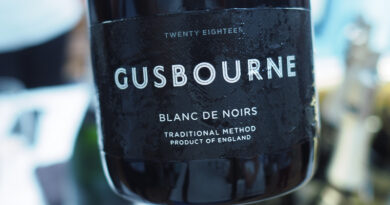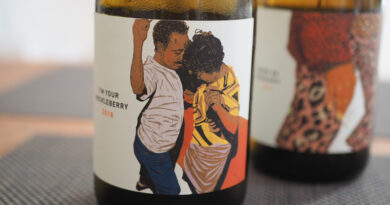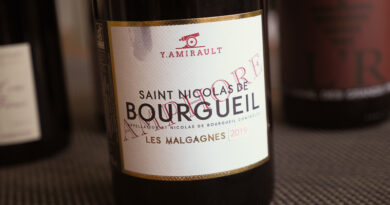Sakkie Mouton: an exciting new producer from the Cape’s West Coast
Website: https://www.smfw.co.za/
Sakkie Mouton wanted to be a musician but he’s ended up making some thrilling wines from the West Coast where his family have a farm. I meet him at Noble Rot Mayfair to try through some of his wines.
Sakkie Mouton grew up on the west coast of the Cape, in Vredendal. ‘I went to school there and the first time leaving the region was to study at Elsenberg,’ he says. ‘But I wanted to become a musician.’
Music is still important to him, even if he never pursued it as a profession. He plays guitar and harmonica. ‘I wanted to study sound engineering but my dad said, you are from a farm.’ So his father wasn’t favouring the musical direction Sakkie wanted to take, but he made a deal: if Sakkie were to study something agricultural first, in case he we were to take over the family farm, then he had his father’s support do whatever he wanted afterwards.
So Sakkie headed to Elsenberg, the agricultural school. But when he saw the winemaking students, they were a group by themselves, with long hair and a sense of coolness. ‘I could see myself in that,’ he says. ‘I realised I could create something, using vineyards as a palette.’
He graduated and then spent five went travelling doing harvests – USA twice (Dry Creek both times), Germany (Weingut Kopp in Baden), France (Le Grappin in Bourgogne) and NZ (Babich in Marlborough). At one time he was an assistant winemaker at Orange River Cellars. He then worked at Muratie as assistant winemaker, and this is where he made the first vintage of Revenge of the Crayfish.
The region he’s from is dominated by cooperative wineries, but he decided that this is where he wanted to make wine. He found a vineyard that was owned by a friend of his dad. It was remote with harsh terrain – a sandy spot planted to Chenin in the middle of nowhere. But how could he make this wine stand out: after all, there are lots of people making Chenin. ‘There are 300 great Chenins in South Africa,’ says Sakkie. ‘I don’t want to put Chenin on the label.’ So he decided to do a wine label based on the 1950s horror movie poster genre. Crayfish diving is big on the west coast, but he thought, what if the crayfish have their revenge? Hence the label, which doesn’t even mention Chenin.
Sakkie left Muratie in 2019, then went to Oregon for five months to work with Chardonnay and Pinot Noir. He got back in December with 90 000 Rand in his bank account, and with this he had to start a winery and buy barrels and equipment.
A west coast winery called Fryers Cove contacted him and allowed him to make his wine there if he made their wine also. But DGB bought Fryers Cove 10 months later, without him knowing, and so he left. He had his six barrels of wine, his total production of the 2020 vintage. He moved the barrels to Cape Town Wine Hub in Somerset West, where he bottled the wines.
Then in in 2021 he started renting an old winery in Wellington. It was 7000 rand a month, but there was nothing much there apart from some stainless steel tanks and a cooling system that didn’t work. He had a basket press so everything was foot stomped that year. After 2021 he moved to Riebeek Kasteel, renting space at the Riebeek Cellars, where 2022, 2023 and 2024 was made. There’s one press for 14 clients so you have to book in advance! But it’s fine.
What about his musical interests? He now uses them to make music videos for each of his wines. This helped a lot in releasing wines like the Vermentino.
Sourcing grapes was hard at the start, but he’s from the area, which helped. But the vineyards were in a bad state, and all the grapes destined for coops. So now he leases the vineyards and farms them as well, paying per tonne. The local growers get 2400 Rand a ton from the coop, so they need to produce 45 tonnes a hectare to make money. One guy gets as much as 90 tonnes/ha from a Colombar vineyard. Sakkie drops yields to a more reasonable 4 tons/hectare by choosing older vineyards that are less productive. He pays 7000 a ton, paying in 4 months as opposed to 18 months.
One of the emphases is getting new varieties for the region. VinPro are giving farmers 200 or 400 vines of new varieties that they think will work, and the coops are trialling them. There are 14 varieties planted in the west coast including Assyrtiko, Piquepoul, Lledoner Pelut, Agiorgitiko. He’s keen on Vermentino, and because of this project has been able to source some.
THE WINES

Sakkie Mouton Vloedvlak Colombar 2023 Olifantsriver, South Africa
11% alcohol. Lost this vineyard to floods this year (in 2024, but the vineyard will be fine – it’s flood irrigated, anyway), and the picture on the label is the flooded vineyard. This is a 1978 vineyard next to the Olifantsriver, with silty soils. Whole bunch pressed with some stainless steel, some barrels, wild ferment. This is powerful, steely and vivid with a real salty tang to the fresh pear and lemon fruit. No malolactic, so it has a keen acid line, with astonishing precision but also some nice flavour and energy. Finishes bright, very long and salty. This is quite beautiful. 95/100

Sakkie Mouton Sand Erf Vermentino 2023 Koekenaap, South Africa
11.5% alcohol. This is from a vineyard next to the Crayfish vineyard, 15 km from the sea, and there are 400 vines of Vermentino. Two 300 litre barrels wild-fermented with a bit of cooling. Left on gross lees for 5 months, then bottled unfined and unfiltered. The label is his day on an ox, with his grandfather in the background. 2017 plantings. This is so interesting with a rounded citrus and apple character. Sandy soils give a very direct floral, fruity quality: light but with intensity – weightless. There’s a nice acid line and a hint of green pea in the background, with some salinity. Such precision. 94/100

Sakkie Mouton Revenge of the Crayfish 2023 Koekenaap, South Africa
13.5% alcohol. 10 km from the ocean, so there’s a cool mist every morning. It then gets really hot in the afternoon, and there’s a cool night of 10 C even on a hot day. When he first started he picked very early; now he’s picking a little later and it works well. With the way he farms the vineyard can handle heat better and so he’s not scared of heat waves, and allows the flavours to develop. Sandy soils. He’s changed pruning to keep stronger shoots, and drops crop to one bunch per shoot. It’s Chenin Blanc, 50% old 500 litre barrels, 50% stainless steel, aged 9 months on lees. This was a cool vintage. Lively and textural with bright lemon and green apple fruit, with precision, sharpness, energy and just a hint of creamy depth with lovely brightness, energy and salinity. Juicy and delicious. Quite unique for a Chenin Blanc. 94/100

Sakkie Mouton Dawn of the Salty Tongues Rouge 2022 Olifantsriver, South Africa
13% alcohol. Salty tongue refers to swearing a lot, and also it’s a salty wine. Syrah from their farm. The vineyard was neglected and run down. It was planted in 1999. 30% whole bunch, three pump overs a day. The first three vintages were dumped because they weren’t good enough, and this is the first release. Sweetly aromatic with a slight creamy edge to the cherry and raspberry fruit. Fresh and fine with lovely texture and elegance. It’s flavourful but light, and gently extracted with purity and finesse, showing a saline twist, a hint of cured meat, and lovely energy. Very exciting. 95/100
UK agent: Woodwinters




